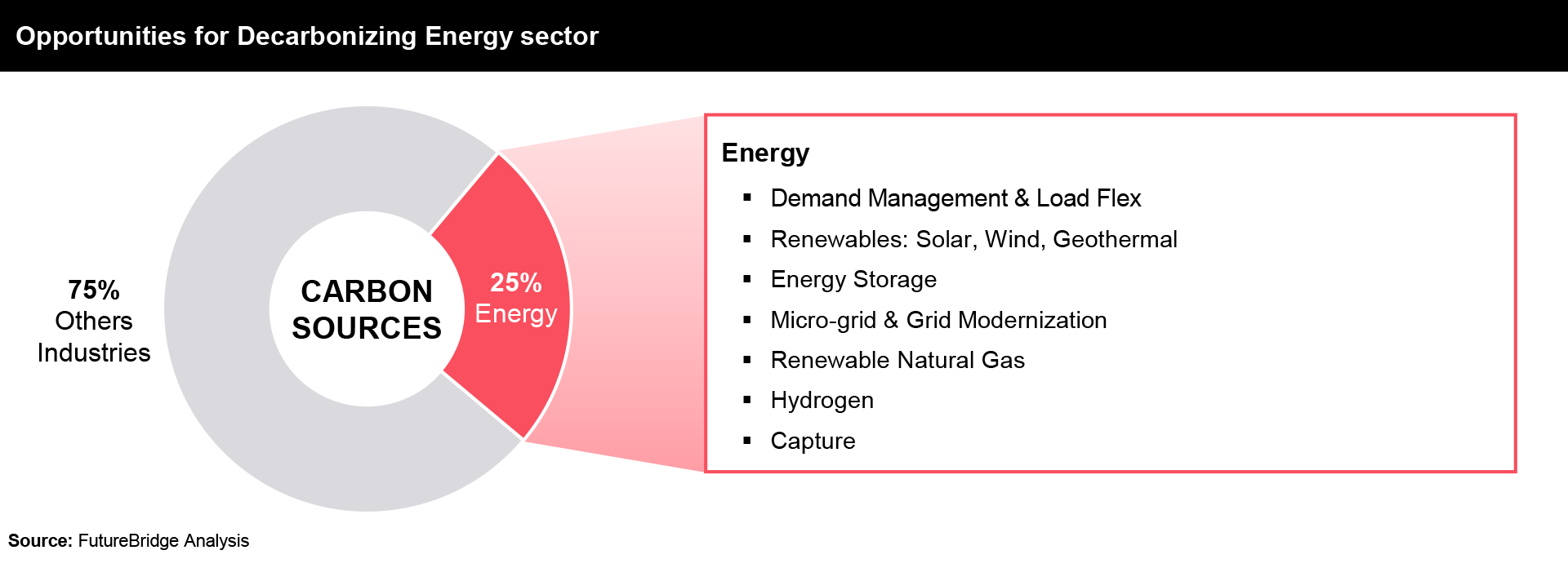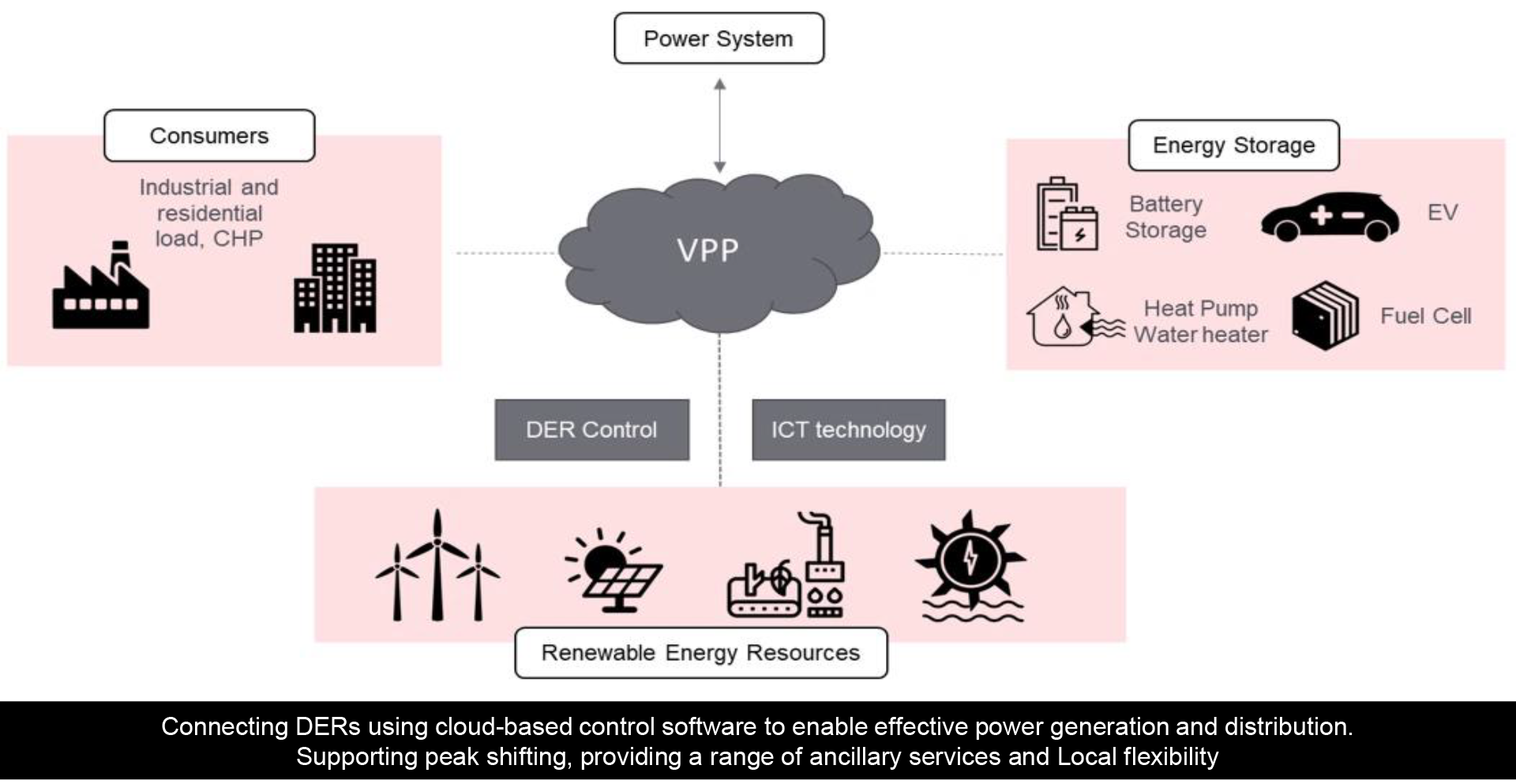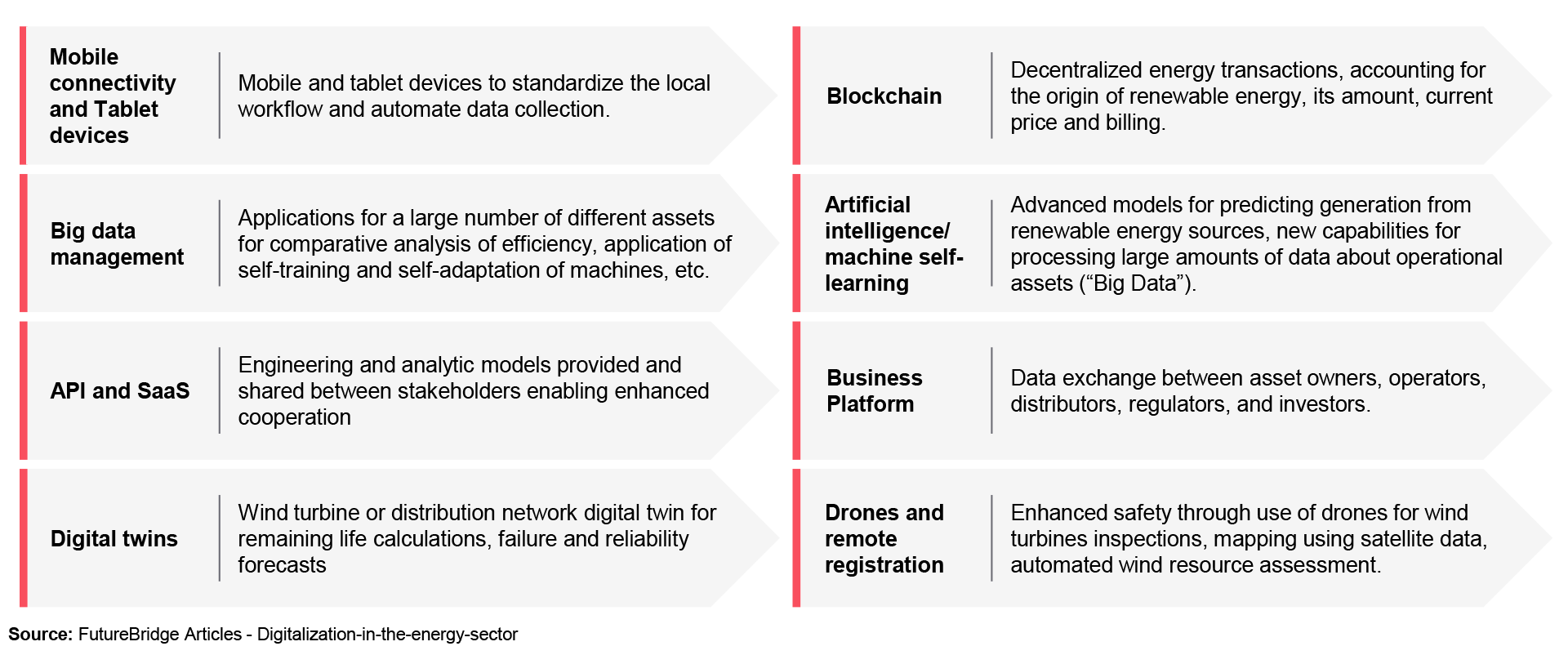The energy transition has become a global reality. To achieve green development, the industry needs to focus on three areas where more innovation is needed: improving the energy efficiency of digital infrastructure, increasing the share of renewables in electricity generation, and decarbonizing industries. A green and intelligent world is fast approaching, for which collaboration and unprecedented Research & Development, is the way forward.
A digital revolution is sweeping the global energy sector with energy industries producing ever more data and firms harnessing greater computing power, advances in data science, and increased digital connectivity to exploit that data. These trends have the potential to transform the way energy is produced, transported, and consumed. Through the process improvement and efficiency benefits, the digital transformation initiatives in the energy sector have the potential to help reduce the rate of increase of global emissions of Green House Gases (GHG), responsible for climate change.
By enabling clean energy systems that rely on low-carbon energy sources and are highly efficient in using energy, digital innovations in the energy sector can speed up decarbonization by ensuring faster Research & Development (R&D), improving project execution, and ensuring effective knowledge transfer initiatives. Yet they are not guaranteed to do so. An instance on digital innovations would be that it could improve global greenhouse emissions by making it easier to extract fossil fuels.
Decarbonization
Decarbonization is the first and foremost element in accelerating the energy transition. Decarbonization of the energy system will require a massive transformation in the way energy is provided, transported, and used. However, views on what the system should or would look like in 2050, still strongly diverge.
According to the Intergovernmental Panel on Climate Change, electricity production emits approximately 37% of global emissions, therefore, cleaning up the electricity with low-carbon sources i.e. nuclear power, hydropower, wind, and solar could deliver a huge reduction in carbon emissions coming from our energy system.
With the advancement in technology, for most industries, carbon footprint reduction would involve a unique combination of infrastructure upgrades, data management, digital solutions, etc.


Digitalization
The critical role of digital technology and innovation is becoming more visible in keeping society moving. Yet, to fully activate the world-changing potential of digital technology, the information and communications technology sector must lead the way by managing the responsible development, deployment, and use of its products and services.
Some of the interventions that are fundamentally changing energy systems are Smart Grids, Smart metering, Smart building (Energy management solutions), Drones (Construction monitoring, Pipeline monitoring, etc.), Underwater ROVs for subsea operations for offshore wind, Predictive maintenance, Leakage/emissions monitoring, remote operations for offshore, etc.
Critical to the successful energy transition is digital transformation, which has received a further boost in the wake of the pandemic. Decarbonization and Decentralization of energy using renewables have increased the complexity of running the energy system. This added complexity requires management, and that management requires a high level of digitalization to ensure the reliability and security of the energy system.
As thousands of new agents are getting connected to the energy ecosystems there is a need for the development and deployment of a high degree of sophisticated automation and analytics tools to manage a system powered by an increasing variety of energy sources.
Supporting technologies such as predictive artificial intelligence, machine learning, the Internet of Things, and blockchain are going to play a critical role in the development of an integrated, renewable, and efficient energy system.
Digitalization Opportunities in key sectors
Digitalization presents significant opportunities in key sectors such as Power and Oil & Gas. Embracing digital transformation in these sectors is crucial for achieving sustainability goals and driving future growth through enhanced efficiency, reduced operational costs, and minimized environmental impact.
Power
The digitalization pathway offers innovative technology for decarbonization, one of which is the Virtual Power Plant. Virtual Power Plant (VPP) is the combination of multiple sites, technologies, and assets that are integrated using specialized software and hardware to form a virtual energy network that can be centrally controlled while maintaining independence. It is a concourse of dispatchable and non-dispatchable Distributed Generation (DG), energy storage elements, and controllable loads. It is accompanied by information and communication technologies to form a single imaginary power plant that plans, monitors the operation, and coordinates the power flows between its components to minimize the generation costs, minimize the production of greenhouse gases, maximize the profits, and enhance the trade inside the electricity market.
As Distributed Energy Resources (DERs) and Demand Response (DR) become more prevalent in electricity supply systems, Virtual Power Plants’ (VPP) role will become more crucial in managing the assets and infrastructure to support the power industry decarbonization.
- Load Shifting: VPP Aggregators can enable real-time shifting of commercial and industrial loads to provide demand-side management (DSM) services to grid operators, based on grid and retail tariffs.
- Balancing Services: VPP Aggregators can use optimization platforms to provide a range of ancillary services, increasing the system’s flexibility to integrate variable DER resources. Aggregators can mitigate the ramps (ups and downs) caused by variable generation output.


- Local Flexibility: VPP Aggregators can provide flexibility at the distribution system operator (DSO) level in the regional/ local market for flexibility.
- Optimizing Investment: Optimizing investment in power system infrastructure: An aggregator can bundle and control the DERs to provide real-time operating reserve capacity that can participate in ancillary markets when required. Improvements and advancements in energy management systems will enable the integration of more renewable sources of power generation. This will lead to rapid decarbonization in the power industry. Digital technologies are helping to upend the traditional model in some key ways, accelerating the decarbonization of the power system and enabling the power system to serve as the backbone for decarbonizing the rest of the economy.
Oil & Gas
Digitalization in the oil and gas sector, such as through sensors and analytics, can help with preventative maintenance, detect emission leaks across the value chain, and improve the reliability of pipelines. Digital technologies such as sensors, drones, and data analytics can help with remote monitoring and automated responses to detect and reduce methane emissions leaks.
Broadly, digitalization is creating new opportunities to reduce the environmental footprint of the oil and gas sector. In August 2020, 15 companies across economic sectors including BP, Equinor, Intel, and Shell formed the Open Footprint Forum to develop open and vendor-neutral industry standards for measuring and reporting environmental footprint data, starting with greenhouse gas emissions data. Open, consistent, and interoperable standards will allow companies to link various systems to measure and verify their environmental footprint across the supply chain to help them find ways of reducing their emissions.
Applications of digital technology in the energy industry


Decarbonization with Digital Twins
With this article, we are briefly covering Digital Twins, as one of the Digitalization technologies.
Digital Twin is a virtual mirror/replica of an ongoing process and/or physical asset replica that relies on massive, cumulative, real-time data measurements to mimic any changes that occur throughout its lifecycle, thus creating an evolving digital profile that provides important insights on its performance, which leads to actions in the physical world.
The possibilities are limitless for Digital Twins technology, and the realization that digital twins may hold the key to unlocking the potential of the combined technology is starting to happen. A digital twin is a digital representation of a physical object commonly seen in the case of wind turbines, but can also be developed for larger objects such as buildings or even whole cities.
The energy sector thrives on efficiency, and digital twins hold the potential to maximize every drop of efficiency out of a facility and bring the output to the limit. With an exact digital replica, one can spot breakdowns and inefficiencies 30 to 60 days ahead of the event, drastically reducing periods of higher consumption. In nuclear energy facilities, it can cost millions to bring a reactor back online after a technical fault, the cost saving is categorically undeniable.8
Innovators have developed the capabilities to model interconnectivity and complete systems that mirror physical set-ups to fully comprehend data. The aim of this is to reduce energy consumption by spotting data anomalies with energy usage. The potential is enormous in this regard, studies have shown that the deployment of digital twins can reduce global carbon emissions by up to 20% by 2030.
Use CaseDecarbonization through digital twin utilization is also possible through environmental virtual modeling. This solution bridges the gap between the virtual and real world by constantly imputing data collected from IoT devices. The virtual twin then optimizes the efficiencies available by locating energy anomalies, which identifies the exact route to decarbonization. Nanyang Technological University (NTU) has recently utilized digital twins to yield an energy saving of more than $3.9 million a year. The 1.1 million square meter space has been transformed into one of the world’s first smart cities. This concept has helped them commit to a reduction of 8.2 million tonnes of carbon yearly. |
What Next???
The potential of digital technologies to help reduce GHG emissions is generating a lot of enthusiasm. One recent analysis claimed that digital technologies could contribute as much as one-third of the 50% GHG reduction required by 2030—more than the current carbon footprints of the European Union and the United States combined.
Technologies such as 5G, the Internet of Things (IoT), drones, Augmented and Virtual Reality, and Artificial Intelligence (AI) are being applied across a spectrum of applications in energy production. Digital technologies have the potential to reduce emissions.
Turbine twins and wind farms are becoming test beds for digital twins as operators investigate ways to maximize efficiency in a sector growing at around 20% per year.
For example, GE Renewable Energy has built several digitally twinned projects to show how the technology can be used. The farms begin as computer models that simulate local wind conditions and enable engineers to configure the most efficient pole height, rotor diameter, and turbine output. Once the turbines are spinning, sensors inside each turbine monitor parameters from the yaw of the nacelle to the generator’s torque and the blade tips’ speed. Digital twins use physics models built into their software to process data, simulate options, and suggest improvements. Improved maintenance means the infrastructure can last for longer.
Oil and gas companies already have incorporated many of the tools important to address their operational challenges, such as equipment maintenance and reliability, remote operations, and asset integrity. Industries can leverage the strength of disruptive digital technologies such as machine learning, digital twins, augmented reality, AI, integrated data platforms, and other solutions to optimize their production and reduce emissions including identifying and recording fugitive emissions in both upstream and downstream sectors.
Apps for smart electricity grids, artificial intelligence, and the Internet of Things promise improved energy management and greater energy efficiency. One such example is BP’s APEX IoT project. APEX is a production optimization solution that uses integrated asset models to optimize production. This application has helped the production engineers to decrease the simulation time from 24-30 hours to just 20 minutes. Digital tools could be one of the keys to Europe’s green future if managed right. By promoting energy saving and management, digital technologies, such as artificial intelligence, Internet of Things, and smart mobility, can cut up to 15% of global carbon emissions. gesi.org studies suggest the number could be as high as 20% by 2030.
The potential applications of smart, connected technology for decarbonization
- Smart energy systems that connect intermittent renewable supply via smart grid technology to distributed energy storage, electric vehicles, and smart homes, enabling whole new prosumer markets.
- Smart buildings that optimize energy usage, making use of smart systems to regulate lighting, heating, ventilation and air conditioning (HVAC), power generation, and energy storage opportunities.
- Multi-modal, automated transport systems that seamlessly integrate public transport with automated vehicles and reduce the need for owning and running cars.
- Low-carbon logistics use sensors, smart packaging, and big data to drive radically more efficient logistics through open warehousing, optimized haulage, load consolidation, back-hauling, and promote circular flows of goods and materials.
- Re-engineered supply chains that harness automation and additive manufacturing to bring down costs, enabling production to be brought closer to the point of consumption, and localizing supply chains to reduce shipping and aviation and their associated emissions.
- Cleaner industrial production based on the use of 5G connectivity, smart sensors, and automation to optimize processes, and material use, and detect harmful leakages, e.g. from gas pipelines.
- Protection of forests and carbon sinks through the use of sensors and drones to monitor forests, detect illegal logging or plantation growth, and even regenerate forests through automated tree planting.
The Way Forward!
ICT solutions, including IoT, machine learning, automation, and smart grid technology have great potential to reduce carbon emissions globally, in numerous sectors and industries for sustainable energy management. Existing ICT solutions have an estimated potential to reduce global carbon emissions by up to 20%. In terms of global decarbonization, this equals around one‑third of the halving of emissions deemed crucial by 2030.
While digital and technology solutions may appear to be the obvious option at times, there are challenges to overcome and potential side effects to be mindful of. Digital infrastructure still has a long way to go before it can fully realize the potential of digital solutions. Furthermore, the rising usage of IoT and AI poses issues of privacy, trust, and security that must be addressed for citizens and the public sector to accept them. For example, when it comes to automating energy access for thousands of homes, the ‘black box’ nature of machine learning can be troublesome.
When it comes to rebound effects from increased digitization, there’s a chance that efforts to decarbonize sectors through digitalization will lead to increased energy and resource demand. The EU’s digital policy emphasizes the need for the ICT sector to undergo “a green transformation.” The environmental impact of electronic and electrical equipment, as well as data centers and cloud services, is substantial and must be separated from emissions and waste.
The ICT sector is predicted to consume 5-9 percent of global electricity consumption, accounting for over 2% of global emissions. For example, estimates show that Bitcoin technology consumes roughly the same amount of energy as Switzerland.
Therefore, realizing the potential of digitalization’s role in decarbonization as a way forward will require policies to increase investments in research, development, demonstration, deployment, infrastructure, and technical outreach and analysis.
_____________
Want to know more about Digitalization in Decarbonization or have a research requirement? Share your business objective with us and our Energy experts will reach out to you.
_____________
Need a thought partner?
Share your focus area or question to engage with our Analysts through the Business Objectives service.
Submit My Business ObjectiveOur Clients
Our long-standing clients include some of the worlds leading brands and forward-thinking corporations.
- © 2021 Cheers Interactive (India) Private Limited. All rights reserved. FutureBridge ® is a registered trademark of Cheers Interactive (India) Private Limited.




































